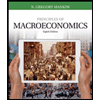
(a)
To compute:
The maximum increase in the money supply, if the reserve requirement is
Answer to Problem 15E
If the reserve requirement is
Explanation of Solution
Given information:
The banking system has vault cash of
As in the
Total liabilities are of $10,000.
Calculation for increase in money supply:
Working Note:
Calculation for the required reserve:
Calculation for the excess reserve by calculating total legal reserve:
Now, calculation of excess reserve:
Calculation for the deposit expansion multiplier:
It refers to a certain amount of cash from the deposit that a bank needs to keep according to the guidelines of the central bank.
Required reserve is calculated by,
Here, RR is reserve, r is percentage of required reserve and D is the total amount in deposits.
Excess reserve:
It refers to the amount left after separating the required reserve ratio of the financial institution.
(b)
To compute:
The
Answer to Problem 15E
The excess reserve of the banking system after Fed buys $100 bonds $900.
The maximum increase in money supply after the Fed buys $100 bonds is $4,500.
Explanation of Solution
Given information:
The banking system has vault cash of
According to the given information, the change in balance sheet after the Fed buys the
| Particulars | Amount ($) | Particulars | Amount ($) |
| Vault Cash | Demand deposits | ||
| Deposit in Fed | $2,000 | ||
| Bonds | $100 | ||
| Loan | |||
| Total |
Table (1)
Calculation for excess reserve:
Therefore, the excess reserve would be $900.
Calculation for increase in money supply:
The maximum increase in money supply after the Fed buys
Working Note:
Calculation for the required reserve.
Calculation of the excess reserve by determining total legal reserve.
To calculate maximum increase in the money supply, calculate the deposit expansion multiplier.
Required reserve:
It refers to the certain amount of cash from the deposit that a bank needs to keep according to the guidelines of the central bank.
Required reserve is calculated by,
Here, RR is reserve, r is percentage of required reserve and D is the total amount in deposits.
Excess reserve:
It refers to the amount left after separating the required reserve ratio of the financial institution.
Want to see more full solutions like this?
Chapter 13 Solutions
EBK MINDTAP ECONOMICS FOR BOYES/MELVIN'
- 17. Given that C=$700+0.8Y, I=$300, G=$600, what is Y if Y=C+I+G?arrow_forwardUse the Feynman technique throughout. Assume that you’re explaining the answer to someone who doesn’t know the topic at all. Write explanation in paragraphs and if you use currency use USD currency: 10. What is the mechanism or process that allows the expenditure multiplier to “work” in theKeynesian Cross Model? Explain and show both mathematically and graphically. What isthe underpinning assumption for the process to transpire?arrow_forwardUse the Feynman technique throughout. Assume that you’reexplaining the answer to someone who doesn’t know the topic at all. Write it all in paragraphs: 2. Give an overview of the equation of exchange (EoE) as used by Classical Theory. Now,carefully explain each variable in the EoE. What is meant by the “quantity theory of money”and how is it different from or the same as the equation of exchange?arrow_forward
- Zbsbwhjw8272:shbwhahwh Zbsbwhjw8272:shbwhahwh Zbsbwhjw8272:shbwhahwhZbsbwhjw8272:shbwhahwhZbsbwhjw8272:shbwhahwharrow_forwardUse the Feynman technique throughout. Assume that you’re explaining the answer to someone who doesn’t know the topic at all:arrow_forwardUse the Feynman technique throughout. Assume that you’reexplaining the answer to someone who doesn’t know the topic at all: 4. Draw a Keynesian AD curve in P – Y space and list the shift factors that will shift theKeynesian AD curve upward and to the right. Draw a separate Classical AD curve in P – Yspace and list the shift factors that will shift the Classical AD curve upward and to the right.arrow_forward
- Use the Feynman technique throughout. Assume that you’re explaining the answer to someone who doesn’t know the topic at all: 10. What is the mechanism or process that allows the expenditure multiplier to “work” in theKeynesian Cross Model? Explain and show both mathematically and graphically. What isthe underpinning assumption for the process to transpire?arrow_forwardUse the Feynman technique throughout. Assume that you’re explaining the answer to someone who doesn’t know the topic at all: 15. How is the Keynesian expenditure multiplier implicit in the Keynesian version of the AD/ASmodel? Explain and show mathematically. (note: this is a tough one)arrow_forwardUse the Feynman technique throughout. Assume that you’re explaining the answer to someone who doesn’t know the topic at all: 13. What would happen to the net exports function in Europe and the US respectively if thedemand for dollars rises worldwide? Explain why.arrow_forward
 Essentials of Economics (MindTap Course List)EconomicsISBN:9781337091992Author:N. Gregory MankiwPublisher:Cengage Learning
Essentials of Economics (MindTap Course List)EconomicsISBN:9781337091992Author:N. Gregory MankiwPublisher:Cengage Learning Principles of Economics (MindTap Course List)EconomicsISBN:9781305585126Author:N. Gregory MankiwPublisher:Cengage Learning
Principles of Economics (MindTap Course List)EconomicsISBN:9781305585126Author:N. Gregory MankiwPublisher:Cengage Learning Brief Principles of Macroeconomics (MindTap Cours...EconomicsISBN:9781337091985Author:N. Gregory MankiwPublisher:Cengage Learning
Brief Principles of Macroeconomics (MindTap Cours...EconomicsISBN:9781337091985Author:N. Gregory MankiwPublisher:Cengage Learning Principles of Macroeconomics (MindTap Course List)EconomicsISBN:9781305971509Author:N. Gregory MankiwPublisher:Cengage Learning
Principles of Macroeconomics (MindTap Course List)EconomicsISBN:9781305971509Author:N. Gregory MankiwPublisher:Cengage Learning Exploring EconomicsEconomicsISBN:9781544336329Author:Robert L. SextonPublisher:SAGE Publications, Inc
Exploring EconomicsEconomicsISBN:9781544336329Author:Robert L. SextonPublisher:SAGE Publications, Inc Macroeconomics: Private and Public Choice (MindTa...EconomicsISBN:9781305506756Author:James D. Gwartney, Richard L. Stroup, Russell S. Sobel, David A. MacphersonPublisher:Cengage Learning
Macroeconomics: Private and Public Choice (MindTa...EconomicsISBN:9781305506756Author:James D. Gwartney, Richard L. Stroup, Russell S. Sobel, David A. MacphersonPublisher:Cengage Learning





